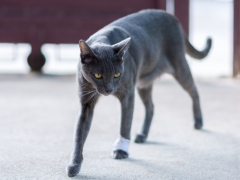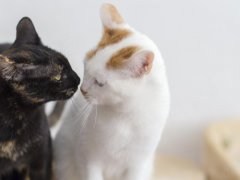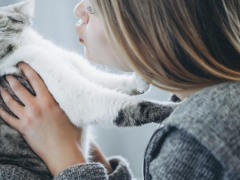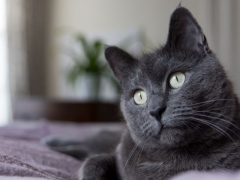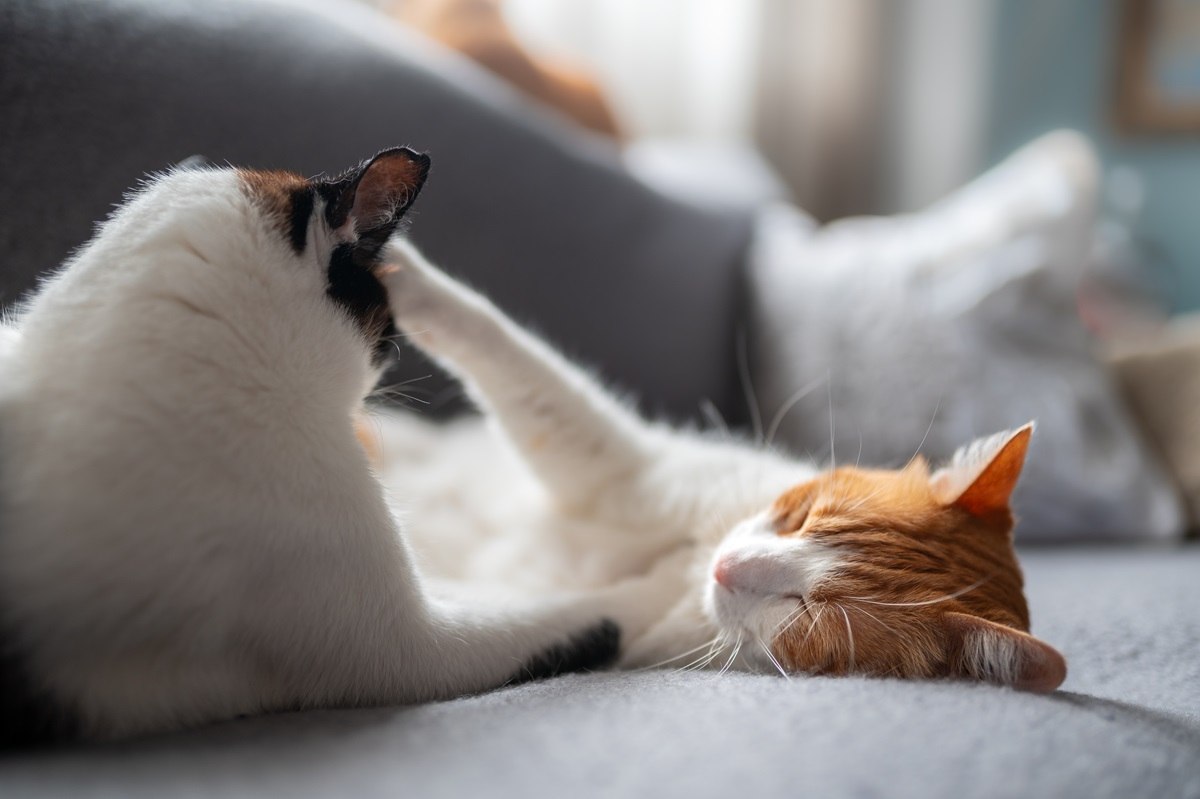
Magui RF / Shutterstock.com
Do you live with a self-assured cat that dominates the couch, displaces other pets from their food bowls, or starts fights? Do you wonder how to address your cat’s behavior?
Moving beyond terms like “top dog” or “alpha cat” is crucial. By observing the behaviors and social dynamics of feral cat communities, we can learn valuable lessons about the behaviors of domestic cats. It’s not just about recognizing a cat’s unwanted behavior, but about identifying the motivation for the behavior and knowing how to respond appropriately. With this knowledge, you can feel more confident as a cat owner and help meet your cat’s needs.
Debunking the Myth of Alpha Cats
The term “alpha cat” is often misused to label cats that exhibit assertive behavior. Examples include chasing other cats, showing aggression toward humans or animals, demanding attention and food, and not always obeying their owner, even when reprimanded.
Once considered universal, the concept of a hierarchy led by an “alpha” is now recognized as applicable only to select species, such as lions and apes. It’s time to debunk this myth about domestic cats so we can understand our cats better.
Cats and dogs have distinct evolutionary histories and behaviors. As independent and highly territorial creatures, cats do not conform to pack animal behavior like dogs. Unlike dogs, cats are not interested in pleasing us, and sometimes, you might feel that we are the ones who are actively trying to satisfy them.
The concept of the “top cat” is a widely misunderstood myth. Cats do not use force to dominate humans or other pets. Instead, they make social choices based on previous experiences, their own natural sociability, and the availability of resources in the home. If conflict arises, cats typically prefer to walk away rather than fight unless there are no other options to resolve the issue.
Instead of labeling our cats as “alpha female cats,” understanding and fulfilling their needs and desires is crucial. This approach can bring about change and lead to more harmonious relationships.
Social Structures in Cat Colonies
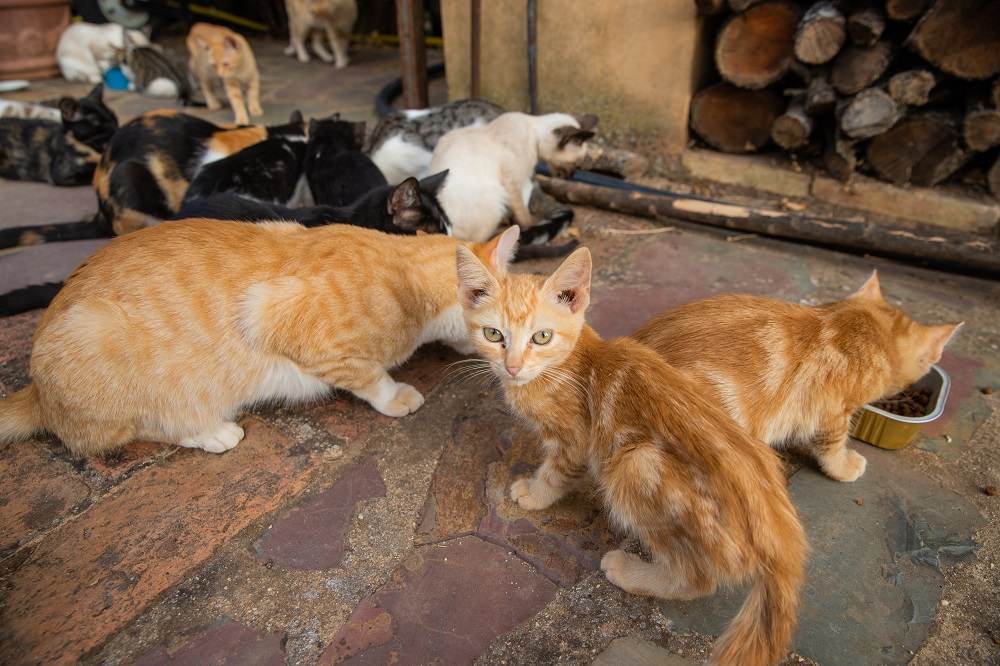
Feral cats living in colonies have complex social structures but they are not based on pack behavior. rai106 / Shutterstock.com
Feral cats, living independently from human intervention, establish intriguing, matrilineal societies known as feral colonies. Unlike the hierarchical structures of wolves or dogs, these societies are built on blood relations traced through the mother’s gene pool. The size of these colonies is determined by the availability of food sources and the density of cats, resulting in the coexistence of both large and small colonies. In areas with limited food, individual cats can survive, revealing the true nature of the solitary cat.
The cat colony is a testament to the remarkable cooperation among adult females in caring for and rearing kittens. This cooperation includes communal nesting, grooming, and safeguarding. The collective relationship between females forms the social structure of the colony. Intact males might be closely associated with a specific colony or have core areas that overlap with several colonies.
Dominant males typically have larger territories than female groups. Amicable behaviors between males and females can occur during familiarity. However, there is no cooperation in hunting, an activity that’s never shared.
Cats recognize colony members versus non-colony members. Social interactions are maintained through affiliative behaviors like nose touching, allorubbing, allogrooming, and sleeping curled up. Such friendships do not affect gender and can occur between males, females, or a male and female.
Inter-cat aggression is not common within colonies. Hostility usually arises when male kittens reach sexual maturity and are excluded from the group, or between males and females as the Tom “patrols” his territory. Toms are rarely aggressive toward females, but females, if sexually receptive, often antagonize male cats that approach too closely.
Typically, all the colony members will exhibit aggression toward unknown cats not part of the group. Particular cats might fail to form friendly relationships with other cats within a colony, which can affect cooperation and lead to hostilities when accessing resources.
Hierarchies in Feral Cats
Feral cat hierarchies, while not explicitly linear, are a fascinating blend of age, sex, personality, and relatability. The higher-ranking cats are typically older females who access resources first. The remaining cats determine the best daily access to resources, which can change frequently. Intact males don’t live within a colony and have a loose hierarchy. The largest male cat is the domineering one, followed by the subservient cat.
Researchers have found that in feral cat groups, there is a social feeding hierarchy. Males eat before females, and larger and older felines consume food before smaller and younger ones. Kittens are given priority in feeding, not only by adult females but also by adult males of the identical group.
The reproductive status can also influence the ever-changing social hierarchy. Females can be highly defensive of their offspring; intact males might assert dominance through urine marking and excessive aggression during mating season.
Cats convey their intentions using subtle signals. A dominant cat will stare at a subordinate, while the inferior cat will avert their gaze. The dominant cat will stiffen and rotate their ears, while the submissive cat will lower or flatten their ears. The assertive cat will elevate the base of their tail, droop the tip and stiffen their limbs, while the docile cat will curl their tail against their thigh and might crouch or lower their body.
Dominant cats tend to stand upright, while subordinates might roll over. Feral cat colonies also utilize vocalizations and olfactory communication, such as urine and feces, to convey friendly or aggressive interactions.
Dominance plays a subtle but crucial role in feral cat colonies. It helps cats navigate within the group by determining what cats to approach, what cats to avoid, and when and where these behaviors are significant.
Domestic Cats: Dynamics of Multi-cat Households
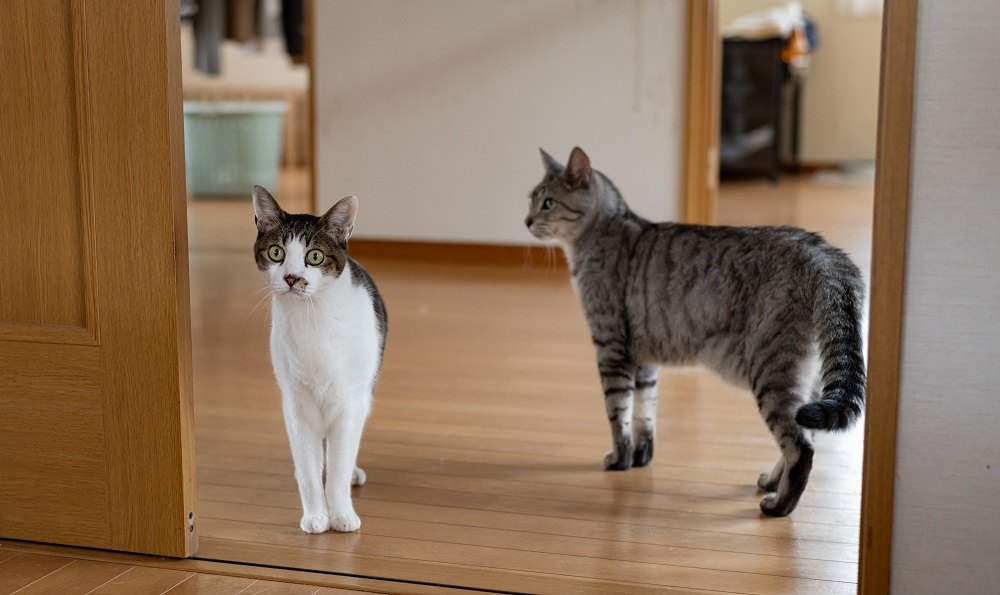
Conflicts can arise in multi-cat households when there aren’t enough resources for all the cats. rai106 / Shutterstock.com
The dynamics of multi-cat households continuously shift due to factors such as the age, sex, and temperament of the cats. For instance, older cats might be less tolerant of playful kittens, while male cats might display more territorial behavior.
The number of cats in the household and whether they are related also play a role. Past experiences with other cats, the size of the residence, and the available territory for each cat also dictate compatibility.
A female is usually at the top of the cat hierarchy in households with multiple cats. Some cats might form smaller groups and try to avoid cats they don’t get along with. Particular cats may dominate specific areas while defending their core territory. Providing enough space and resources can make a big difference in whether a multi-cat household is harmonious or discordant.
Chronic stress can develop when cats don’t have enough space to keep their distance from each other, and an individual can’t adapt or prefers to spend time alone. Behavioral problems such as urine spraying, soiling outside the litter box, or stress-related diseases such as feline idiopathic cystitis (FIC) and overgrooming can develop.
However, if a confident cat has free access to the outdoors, it might establish territory where it perceives resources are ample to fulfill its needs, reducing these risks.
Cat Behavior and Social Dynamics in Multi-Cat Households
Genetics, early life experiences, exposure to other cats, and the living environment influence a cat’s behavior and sociability in multi-cat homes.
Clashes over access to resources can happen daily. Cats do not enjoy sharing essential resources, such as food bowls, resting areas, and toys with other social groups. To minimize tension and conflict, provide enough resources within accessible locations for each cat or collective group. The resource formula is one resource per cat plus one placed in different locations around the home.
Cats’ health issues can affect the relationships between cats in a household with multiple cats. Sudden aggression might occur between resident cats, ranging from mild to severe attacks without any prior conflict.
In our home, our adult female cat, who suffers from arthritis, experiences a change in behavior during the winter due to pain. As a result, she might swipe or bite at the younger kitten if they approach her. Group dynamics also change when our resident cat returns home from a veterinary consultation or hospitalization. The smell elicits fear and redirected aggression from the other resident cats.
Another scenario is during mealtime or when cats are near essential resources like water bowls, litter boxes, and toys. They might become aggressive toward each other. Hence, providing extra litter boxes, bowls, and other resources like warm raised beds in separate locations is necessary to prevent conflict.
Disputes can also happen when cats from different social groups encounter each other in dissimilar parts of their territory. Some cats might block access to these resources or threaten others when approaching them to control them. Adding hiding spots and providing at least two escape routes in different home parts is advisable to reduce fights.
Owners play an essential part in influencing cat behavior. If female cats are more dominant, mellow male cats might distance themselves from their owners and only spend short periods of time on their laps having cuddles.
Bringing a new kitten or cat into a household can disrupt the hierarchy and group dynamics, potentially leading to aggression. Introducing kittens to a group of cats is advisable, as they are usually more readily accepted than adult cats. Nevertheless, it’s essential to introduce them carefully to ensure a smooth transition.
Finally, providing plenty of enrichment, play, and mental and physical stimulation can help reduce tension and improve group interactions within multi-cat households.
Frequently Asked Questions
What is the cat version of an alpha?
The feline equivalent of an “alpha” is a dominant cat within the group. This cat typically asserts its authority through body language, vocalizations, and interactions with other pets, or exhibits unwanted behaviors toward their caregiver.
Do cats have a hierarchy?
Cats do not have a linear hierarchy where one cat is dominant over those below it and displays submission to those above it within social groups. However, aggressive moments can occur over territory and resources, especially in multi-cat households with insufficient assets such as food bowls, beds, toys, and litter boxes for all the cats.
Do cats show dominance over humans?
No, cats don’t show signs of dominance over humans. They don't display emotions such as pride, jealousy, or vindictiveness. They do not deliberately try to dominate or deceive us. If a cat displays aggressive body language toward humans for no apparent reason, this constitutes “problem behavior” and needs behavioral intervention.
-
Yamane, A., Emoto, J., & Ota, N. (1997). Factors affecting feeding order and social tolerance to kittens in the group-living feral cat (Felis catus). Applied Animal Behaviour Science, 52(1–2), 119–127.
-
Liberg, O., Sandell, M., Pontier, D., & Natoli, E. (2000). Density, spatial organization and reproductive tactics in the domestic cat and other felids. ResearchGate.
-
Crowell-Davis, S. L., Curtis, T. M., & Knowles, R. J. (2004). Social organization in the cat: A modern understanding. Journal of Feline Medicine and Surgery, 6(1), 19–28.
-
Scource, B. (2019, March 6). Multi-cat households | International Cat Care. International Cat Care.
-
Scource, B. (2019b, October 6). The social structure of cat life | International Cat Care. International Cat Care.
-
Bonanni, R., Cafazzo, S., Fantini, C., Pontier, D., & Natoli, E. (2007). Feeding-order in an urban feral domestic cat colony: relationship to dominance rank, sex and age. Animal Behaviour, 74(5), 1369–1379.
-
Bernstein, P. L. (2006). Behavior of single cats and groups in the home. In Elsevier eBooks (pp. 675–685).
-
University of Edinburgh. (2019). Understanding feline social structure.
-
Vitale, K. R. (2022). The social lives of Free-Ranging cats. Animals, 12(1), 126.
-
Trevorrow, N. (2015). Behaviour matters. In The Cat: Vol. Winter 2015 (pp. 24–25).
-
Trevorrow, N. (2016). The Cat Spring 2016. In The Cat.
